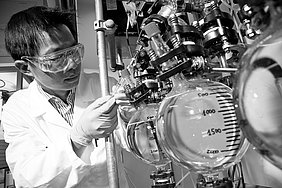Nano-iron(0) technologies are a promising option to rehabilitate contaminated sites. The microbiological degradation of perchloroethene (PCE) was stimulated by using dispersed zerovalent iron (nZVI).
The NAPASAN project should help further develop the manufacturing processes of nanoparticles from zerovalent iron (nZVI) with regard to the selectivity of the pollutants being cleaned away and taking into account economic considerations. The objective of the sub-project was to investigate the synergy effects from abiotic and microbiological CHC dechlorination and to evaluate the potential risks when using nZVI and the dispersion medium during groundwater rehabilitation.
No stimulation of the reductive microbiological degradation of PCE by dispersed nZVI could be shown. Stimulation with nZVI dispersion was more pronounced than for the dispersion medium alone. No long-lasting toxic effects were observed in the field or in the lab as a result of injecting the dispersed nZVI into the investigated organisms. It was not possible to make a quantitative estimation of the proportion of biological processes involved in the total conversion of PCE. By combining physical-chemical testing with molecular biological evidence of the pollutant recyclers present at the site, site-specific synergistic and eco-toxicological effects could be determined.
These effects are dependent on the used nZVI material and the location conditions. As a result of the project, it is recommended that site-specific testing is always performed in advance when using nZVI to evaluate the risks and synergistic effects of abiotic and microbial reductive dechlorination. The molecular biological parameters tested in the project proved to be meaningful and are available for use in the field.
Publications:
Köber R., Hollert H., Hornbruch G., Jekel M., Kamptner A., Klaas N., Maes H., Mangold K.-M., Martac E., Matheis A., Paar H., Schäffer A., Schell H., Schiwy A., Schmidt K. R., Strutz T. J., Thümmler S., Tiehm A., Braun J.: Nanoscale zero-valent iron flakes for groundwater treatment. Environ. Earth Sci. (2014): DOI 10.1007/s12665-014-3239-0.
Schiwy A., Maes H., Koske D., Flecken M., Schmidt K., Schell H., Tiehm A., Kampter A., Thümmler S., Stanjek H., Heggen M., Dunin-Borkowski R., Braun J., Schäffer A., Hollert H.: The ecotoxic potential of a new zero-valent iron nanomaterial, designed for the elimination of halogenated pollutants, and its effect on reductive dechlorinating microbial communities. Environmental Pollution 216: 419-427 (2016) DOI 10.1016/j.envpol.2016.05.051

![[Translate to English:] Prüfstelle-Produktprüfung_Teststand Test centre and product testing](/fileadmin/_processed_/0/9/csm_TZW-Karlsruhe_Pruefung_Geraete-Teststand_377188946c.jpg)

























